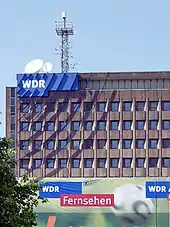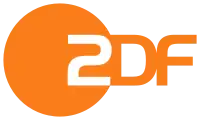Westdeutscher Rundfunk
Westdeutscher Rundfunk Köln (WDR; West German Broadcasting Cologne) is a German public-broadcasting institution based in the Federal State of North Rhine-Westphalia with its main office in Cologne. WDR is a constituent member of the consortium of German public-broadcasting institutions, ARD. As well as contributing to the output of the national television channel Das Erste, WDR produces the regional television service WDR Fernsehen (formerly known as WDF and West3) and six regional radio networks.
 | |
| Country | |
|---|---|
| Founded | 1955 |
| Slogan | "Mehr hören. Mehr sehen." (Hear more. See more.) |
| Headquarters | Cologne |
| Callsigns | WDR |
Callsign meaning | West German Broadcasting Corporation |
| Affiliation(s) | ARD |
| Webcast | WDR TV (Germany Only) |
Official website | http://wdr.de |
History
Origins
The Westdeutsche Funkstunde AG (WEFAG) was established on 15 September 1924.
There was a substantial purge of left wing staff following the Nazi seizure of power in 1933. This included Ernst Hardt, Hans Stein and Walter Stern.

WDR was created in 1955, when Nordwestdeutscher Rundfunk (NWDR) was split into Norddeutscher Rundfunk (NDR) – covering Lower Saxony, Schleswig-Holstein, and Hamburg – and Westdeutscher Rundfunk, responsible for North Rhine-Westphalia. WDR began broadcasting on two radio networks (one produced jointly with NDR) on 1 January 1956. WDR constitutes the most prominent example of regional broadcasting in Germany.[1]
Directors
- 1926–1933: Ernst Hardt, director general of WERAG
- 1933–1937: Heinrich Glasmeier, director general of "Reichssender Köln"
- 1937–1941: Anton Winkelnkemper, director general of "Reichssender Köln"
- 1942–1945: closed
- 1945–1947: Max Burghardt, director general of NWDR
- 1947–1961: Hanns Hartmann, director general of NWDR and since 1956 of WDR
- 1961–1976: Klaus von Bismarck
- 1976–1985: Friedrich-Wilhelm von Sell
- 1985–1995: Friedrich Nowottny
- 1995–2007: Fritz Pleitgen
- 2007–2013: Monika Piel[2]
- since 1 July 2013: Tom Buhrow[3]
Logo history
 WDR's first and original logo used from 1956 to 1970.
WDR's first and original logo used from 1956 to 1970. WDR's second and former logo used from 1970 to 1994.
WDR's second and former logo used from 1970 to 1994..svg.png.webp) WDR's third and previous logo used from 1994 to 2012.
WDR's third and previous logo used from 1994 to 2012. WDR's fourth and current logo since 2012.
WDR's fourth and current logo since 2012.
Funding
WDR is in part funded by the limited sale of on-air commercial advertising time; however, its principal source of income is the revenue derived from viewer and listener licence fees. As of 2015 the monthly fee due from each household for radio and television reception was €17.50.[4] These fees are collected not directly by WDR but by a joint agency of ARD (and its member institutions), ZDF, and Deutschlandradio.
Television
WDR began its regional television service, Westdeutsches Fernsehen (WDF), on 17 December 1965. On 27 August 1967, West Germany turned on it first color TV program, WDF used a live broadcast from a Bosch Fernseh outside broadcast van to start broadcasting in color. In 1988 the channel was renamed West3; since 1994, it has been known as WDR Fernsehen.
While the programmes are mainly run from their Cologne headquarters, they also have a number of sub-regional studios contributing a regular broadcast called Lokalzeit with the addition "aus Aachen" (Aachen), "OWL" (Bielefeld), "aus Bonn" (Bonn), "aus Dortmund" (Dortmund), "aus Düsseldorf" (Düsseldorf), "aus Duisburg" (Duisburg), "Ruhr" (Essen), "aus Köln" (Cologne and Bonn), "Münsterland" (Münster), "Südwestfalen" (Siegen) and "Bergisches Land" (Wuppertal) for each respective region. WDR has its current affairs and regional-politics studios in Düsseldorf.
It has served as the production entity for network shows on Das Erste of ARD, such as Forbidden Love, which over the years introduced many young actors to the German audience, such as Andreas Stenschke, Jo Weil, Luca Zamperoni and Kay Böger. The TV-sport for the “First Channel” Das Erste is produced in Cologne, and WDR contributes to ARD Digital, 3sat and arte.
Radio
.jpg.webp)
A long-running talk show on wheels was Hallo Ü-Wagen, running from 1974 to 2010, begun by Carmen Thomas. WDR's main radio channels are available on FM and digital (DAB+), as well as via cable and satellite:
- 1LIVE is a popular music channel modelled on BBC Radio 1 and aimed at a young audience. Its schedules include such non-mainstream night-time programmes as "Heimatkult", focusing on pop music from Germany, and "Lauschangriff", a series of audio-books.
- WDR 2, featuring adult-oriented popular music, focuses strongly on national and regional news, current affairs, and sport.
- WDR 3, the cultural channel, offers mostly classical, jazz and world music as well as radio drama and spoken-word features dealing with literature and the performing arts.
- WDR 4 (motto: Melodien für ein gutes Gefühl, "Melodies for a good feeling") is a channel aimed chiefly towards an older audience. Its focus is on tuneful music – in particular, oldies and classic hits: popular music of the 1960s to the 1980s or later – with more specialized programming (operetta, country, folk) in the evenings. Around 30-40% of WDR 4's musical output is made up of German-language songs.
- WDR 5 features spoken-word programming with the focus on present-day culture and society. Between 6.05 and 9.45 each Monday to Saturday morning the channel offers news, background briefing, interviews, and correspondents' reports in a sequence entitled Morgenecho. The main lunchtime and early-evening news and current affairs programmes Mittagsecho (at 13.05–14.00 on Mondays to Fridays and 13.30–14.30 on Sundays) and Echo des Tages (at 18.30–19.00 daily) are both co-productions with Norddeutscher Rundfunk (NDR) in Hamburg. Additionally, WDR 2's 30-minute round-up of the day's most important news reports, Berichte von heute, is simulcast by WDR 5 on Monday to Friday evenings at 23.30. WDR 5 also carries children's programming from KiRaKa at 19.05–20.00 each evening as well as on Sundays at 7.05–8.00 and 14.05–15.00.
- Cosmo (earlier WDR 5 Funkhaus Europa – an offshoot of WDR 5 – and now a joint production of Radio Bremen, RBB, and WDR) is a channel principally aimed at serving immigrants and promoting integration. It features a wide selection of world music. It is not available over-the-air in every part of WDR's broadcasting area.
See also
- German television
- Public broadcasting
- Rockpalast
- Studio for Electronic Music (WDR)
- WDR Symphony Orchestra Cologne (WDR Sinfonieorchester Köln)
- WDR Rundfunkorchester Köln
- WDR Rundfunkchor Köln
- WDR Computerclub
Notes
- "Potschka, Christian and Golding, Peter (2012) The structural developments of regional broadcasting in Britain and Germany. Media History 18(3-4): 443-458" (PDF). Retrieved 2014-12-02.
- Westdeutscher Rundfunk (WDR 5) 7 April 2013: "35 Jahre keine Langeweile!" Intendantin Monika Piel verlässt den WDR Archived 17 June 2013 at the Wayback Machine
- DWDL.de: Tom Buhrow tritt am 1. Juli als WDR-Intendant an, by Thomas Lückerath 18 June 2013
- "Archived copy". Archived from the original on 2016-03-04. Retrieved 2016-03-09.CS1 maint: archived copy as title (link)
